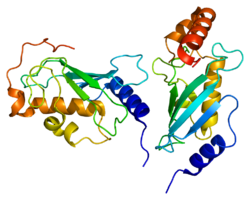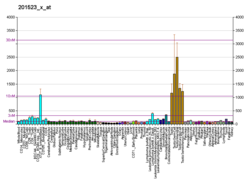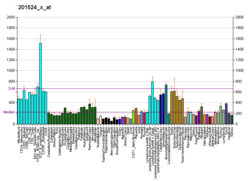Ubiquitin-conjugating enzyme E2 N is a protein that in humans is encoded by the UBE2N gene.[5][6]
Function[edit]
The modification of proteins with ubiquitin is an important cellular mechanism for targeting abnormal or short-lived proteins for degradation. Ubiquitination involves at least three classes of enzymes: ubiquitin-activating enzymes, or E1s, ubiquitin-conjugating enzymes, or E2s, and ubiquitin-protein ligases, or E3s. This gene encodes a member of the E2 ubiquitin-conjugating enzyme family. Studies in mouse suggest that this protein plays a role in DNA postreplication repair.[6]
Interactions[edit]
UBE2N has been shown to interact with:
References[edit]
- ^ a b c GRCh38: Ensembl release 89: ENSG00000177889 – Ensembl, May 2017
- ^ a b c GRCm38: Ensembl release 89: ENSMUSG00000074781 – Ensembl, May 2017
- ^ "Human PubMed Reference:". National Center for Biotechnology Information, U.S. National Library of Medicine.
- ^ "Mouse PubMed Reference:". National Center for Biotechnology Information, U.S. National Library of Medicine.
- ^ Yamaguchi T, Kim NS, Sekine S, Seino H, Osaka F, Yamao F, Kato S (February 1997). "Cloning and expression of cDNA encoding a human ubiquitin-conjugating enzyme similar to the Drosophila bendless gene product". J Biochem. 120 (3): 494–97. doi:10.1093/oxfordjournals.jbchem.a021440. PMID 8902611.
- ^ a b "Entrez Gene: UBE2N ubiquitin-conjugating enzyme E2N (UBC13 homolog, yeast)".
- ^ Ewart-Toland A, Briassouli P, de Koning JP, Mao JH, Yuan J, Chan F, MacCarthy-Morrogh L, Ponder BA, Nagase H, Burn J, Ball S, Almeida M, Linardopoulos S, Balmain A (August 2003). "Identification of Stk6/STK15 as a candidate low-penetrance tumor-susceptibility gene in mouse and human". Nat. Genet. 34 (4): 403–12. doi:10.1038/ng1220. PMID 12881723. S2CID 29442841.
- ^ Unk I, Hajdú I, Fátyol K, Hurwitz J, Yoon JH, Prakash L, Prakash S, Haracska L (March 2008). "Human HLTF functions as a ubiquitin ligase for proliferating cell nuclear antigen polyubiquitination". Proc. Natl. Acad. Sci. U.S.A. 105 (10): 3768–73. Bibcode:2008PNAS..105.3768U. doi:10.1073/pnas.0800563105. PMC 2268824. PMID 18316726.
- ^ a b c Deng L, Wang C, Spencer E, Yang L, Braun A, You J, Slaughter C, Pickart C, Chen ZJ (October 2000). "Activation of the IkappaB kinase complex by TRAF6 requires a dimeric ubiquitin-conjugating enzyme complex and a unique polyubiquitin chain". Cell. 103 (2): 351–61. doi:10.1016/s0092-8674(00)00126-4. PMID 11057907. S2CID 18154645.
Further reading[edit]
- Bonaldo MF, Lennon G, Soares MB (1997). "Normalization and subtraction: two approaches to facilitate gene discovery". Genome Res. 6 (9): 791–806. doi:10.1101/gr.6.9.791. PMID 8889548.
- Hofmann RM, Pickart CM (1999). "Noncanonical MMS2-encoded ubiquitin-conjugating enzyme functions in assembly of novel polyubiquitin chains for DNA repair". Cell. 96 (5): 645–53. doi:10.1016/S0092-8674(00)80575-9. PMID 10089880. S2CID 17117789.
- Deng L, Wang C, Spencer E, Yang L, Braun A, You J, Slaughter C, Pickart C, Chen ZJ (2000). "Activation of the IkappaB kinase complex by TRAF6 requires a dimeric ubiquitin-conjugating enzyme complex and a unique polyubiquitin chain". Cell. 103 (2): 351–61. doi:10.1016/S0092-8674(00)00126-4. PMID 11057907. S2CID 18154645.
- Chan NL, Hill CP (2001). "Defining polyubiquitin chain topology". Nat. Struct. Biol. 8 (8): 650–2. doi:10.1038/90337. PMID 11473244. S2CID 16579945.
- Moraes TF, Edwards RA, McKenna S, Pastushok L, Xiao W, Glover JN, Ellison MJ (2001). "Crystal structure of the human ubiquitin conjugating enzyme complex, hMms2-hUbc13". Nat. Struct. Biol. 8 (8): 669–73. doi:10.1038/90373. PMID 11473255. S2CID 23504541.
- Ashley C, Pastushok L, McKenna S, Ellison MJ, Xiao W (2002). "Roles of mouse UBC13 in DNA postreplication repair and Lys63-linked ubiquitination". Gene. 285 (1–2): 183–91. doi:10.1016/S0378-1119(02)00409-2. PMID 12039045.
- McKenna S, Moraes T, Pastushok L, Ptak C, Xiao W, Spyracopoulos L, Ellison MJ (2003). "An NMR-based model of the ubiquitin-bound human ubiquitin conjugation complex Mms2.Ubc13. The structural basis for lysine 63 chain catalysis". J. Biol. Chem. 278 (15): 13151–8. doi:10.1074/jbc.M212353200. PMID 12569095.
- Anandasabapathy N, Ford GS, Bloom D, Holness C, Paragas V, Seroogy C, Skrenta H, Hollenhorst M, Fathman CG, Soares L (2003). "GRAIL: an E3 ubiquitin ligase that inhibits cytokine gene transcription is expressed in anergic CD4+ T cells". Immunity. 18 (4): 535–47. doi:10.1016/S1074-7613(03)00084-0. PMID 12705856.
- Ewart-Toland A, Briassouli P, de Koning JP, Mao JH, Yuan J, Chan F, MacCarthy-Morrogh L, Ponder BA, Nagase H, Burn J, Ball S, Almeida M, Linardopoulos S, Balmain A (2003). "Identification of Stk6/STK15 as a candidate low-penetrance tumor-susceptibility gene in mouse and human". Nat. Genet. 34 (4): 403–12. doi:10.1038/ng1220. PMID 12881723. S2CID 29442841.
- Bothos J, Summers MK, Venere M, Scolnick DM, Halazonetis TD (2003). "The Chfr mitotic checkpoint protein functions with Ubc13-Mms2 to form Lys63-linked polyubiquitin chains". Oncogene. 22 (46): 7101–7. doi:10.1038/sj.onc.1206831. PMID 14562038.
- Zhou H, Wertz I, O'Rourke K, Ultsch M, Seshagiri S, Eby M, Xiao W, Dixit VM (2004). "Bcl10 activates the NF-kappaB pathway through ubiquitination of NEMO". Nature. 427 (6970): 167–71. Bibcode:2004Natur.427..167Z. doi:10.1038/nature02273. PMID 14695475. S2CID 4429582.
- Sun L, Deng L, Ea CK, Xia ZP, Chen ZJ (2004). "The TRAF6 ubiquitin ligase and TAK1 kinase mediate IKK activation by BCL10 and MALT1 in T lymphocytes". Mol. Cell. 14 (3): 289–301. doi:10.1016/S1097-2765(04)00236-9. PMID 15125833.
- Colland F, Jacq X, Trouplin V, Mougin C, Groizeleau C, Hamburger A, Meil A, Wojcik J, Legrain P, Gauthier JM (2004). "Functional proteomics mapping of a human signaling pathway". Genome Res. 14 (7): 1324–32. doi:10.1101/gr.2334104. PMC 442148. PMID 15231748.
- Pastushok L, Moraes TF, Ellison MJ, Xiao W (2005). "A single Mms2 "key" residue insertion into a Ubc13 pocket determines the interface specificity of a human Lys63 ubiquitin conjugation complex". J. Biol. Chem. 280 (18): 17891–900. doi:10.1074/jbc.M410469200. PMID 15749714.
- Takeuchi T, Yokosawa H (2005). "ISG15 modification of Ubc13 suppresses its ubiquitin-conjugating activity". Biochem. Biophys. Res. Commun. 336 (1): 9–13. doi:10.1016/j.bbrc.2005.08.034. PMID 16112642.
- Zou W, Papov V, Malakhova O, Kim KI, Dao C, Li J, Zhang DE (2005). "ISG15 modification of ubiquitin E2 Ubc13 disrupts its ability to form thioester bond with ubiquitin". Biochem. Biophys. Res. Commun. 336 (1): 61–8. doi:10.1016/j.bbrc.2005.08.038. PMID 16122702.










Well, that’s interesting to know that Psilotum nudum are known as whisk ferns. Psilotum nudum is the commoner species of the two. While the P. flaccidum is a rare species and is found in the tropical islands. Both the species are usually epiphytic in habit and grow upon tree ferns. These species may also be terrestrial and grow in humus or in the crevices of the rocks.
View the detailed Guide of Psilotum nudum: Detailed Study Of Psilotum Nudum (Whisk Fern), Classification, Anatomy, Reproduction